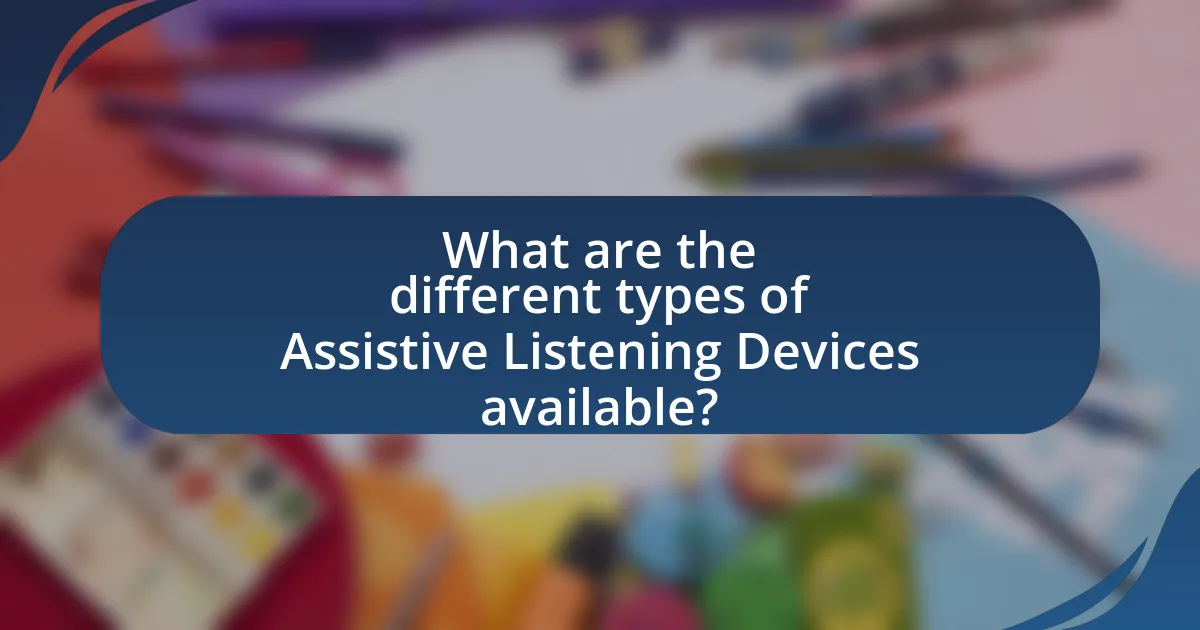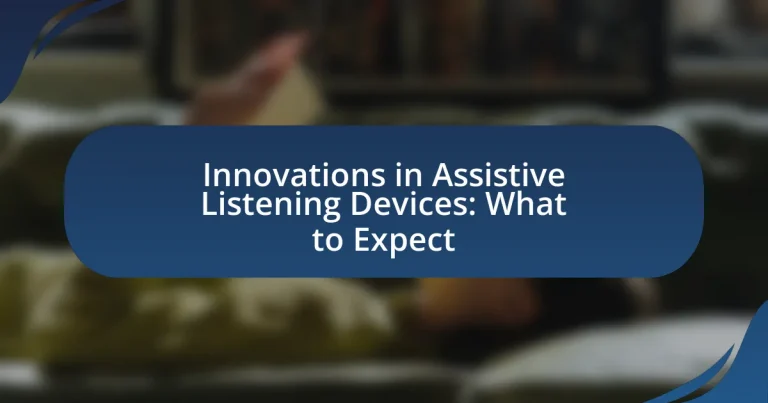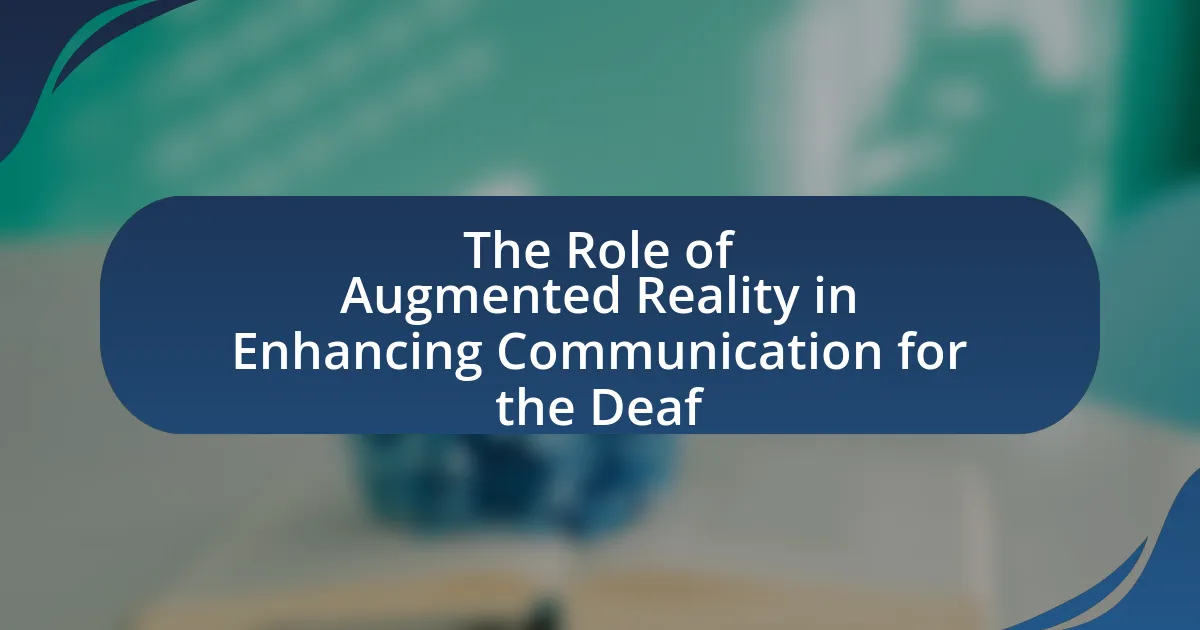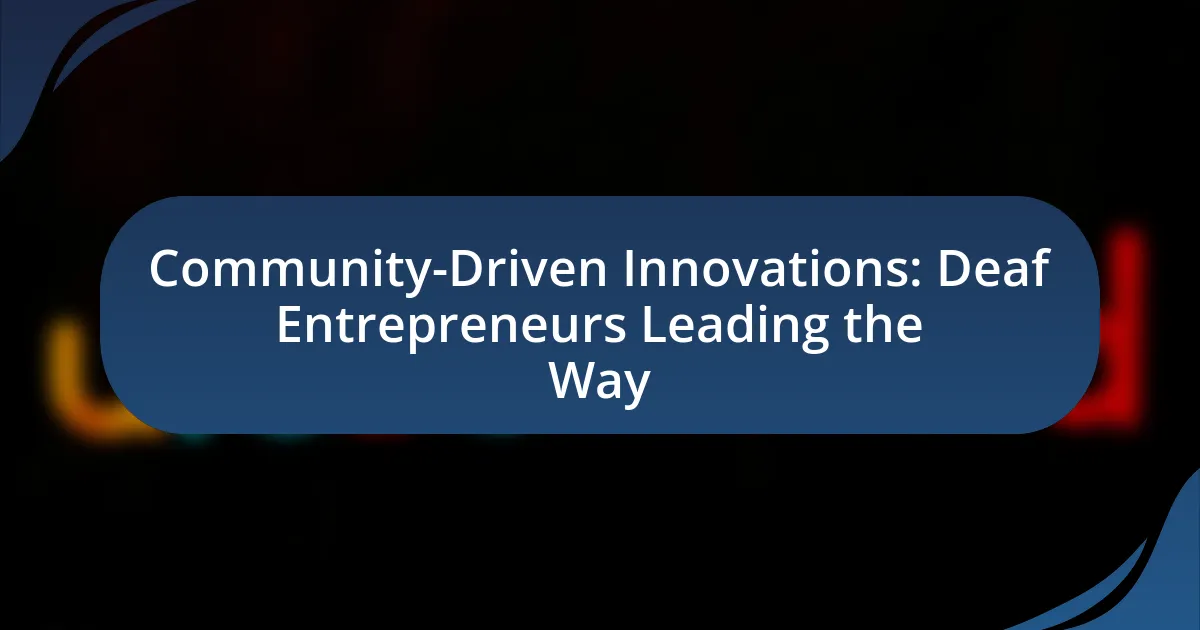Assistive Listening Devices (ALDs) are specialized tools designed to enhance sound perception for individuals with hearing impairments, significantly improving communication and quality of life. This article explores the various types of ALDs, including hearing aids, FM systems, and induction loop systems, and discusses their importance in diverse environments such as classrooms and public spaces. It highlights recent innovations in technology, including artificial intelligence and wireless connectivity, which enhance user experience and accessibility. Additionally, the article addresses challenges faced by manufacturers, factors consumers should consider when selecting ALDs, and best practices for maintenance, ensuring users can maximize the benefits of these essential devices.

What are Assistive Listening Devices and Their Importance?
Assistive Listening Devices (ALDs) are specialized tools designed to enhance sound perception for individuals with hearing impairments. These devices, which include FM systems, infrared systems, and induction loop systems, improve the clarity of speech and reduce background noise, making communication more accessible in various environments such as classrooms, theaters, and public spaces. The importance of ALDs lies in their ability to significantly improve the quality of life for users by facilitating better communication, social interaction, and participation in daily activities, ultimately promoting independence and inclusion. Studies indicate that the use of ALDs can lead to increased satisfaction in social situations and improved academic performance among students with hearing loss.
How do Assistive Listening Devices enhance communication?
Assistive Listening Devices enhance communication by amplifying sound and reducing background noise, which allows individuals with hearing impairments to better understand speech. These devices, such as hearing aids and FM systems, directly transmit sound to the user’s ears, improving clarity and comprehension in various environments. Research indicates that users of assistive listening devices experience significant improvements in communication effectiveness, with studies showing that 80% of users report enhanced understanding in noisy settings.
What types of hearing impairments do Assistive Listening Devices address?
Assistive Listening Devices (ALDs) address various types of hearing impairments, primarily including mild to moderate sensorineural hearing loss, conductive hearing loss, and auditory processing disorders. Sensorineural hearing loss affects the inner ear or auditory nerve, while conductive hearing loss involves problems in the outer or middle ear that prevent sound from being conducted properly. Auditory processing disorders impact the brain’s ability to process auditory information, making it difficult for individuals to understand sounds and speech. ALDs enhance sound clarity and reduce background noise, making them effective for individuals with these specific hearing challenges.
Why are Assistive Listening Devices crucial in various environments?
Assistive Listening Devices (ALDs) are crucial in various environments because they enhance auditory access for individuals with hearing impairments, facilitating effective communication. In settings such as classrooms, theaters, and public spaces, ALDs improve sound clarity and reduce background noise, allowing users to engage fully in conversations and activities. Research indicates that approximately 15% of American adults experience some form of hearing difficulty, highlighting the need for such devices to ensure inclusivity and equal participation in diverse environments.
What innovations are currently shaping Assistive Listening Devices?
Innovations currently shaping Assistive Listening Devices include advancements in wireless technology, integration with smartphones, and the development of artificial intelligence for personalized sound processing. Wireless technology, such as Bluetooth, allows for seamless connectivity between devices, enhancing user experience. Integration with smartphones enables users to control settings and stream audio directly, improving accessibility. Additionally, artificial intelligence is being utilized to adapt sound profiles to individual hearing needs, providing a tailored listening experience. These innovations are supported by research indicating that personalized sound processing can significantly improve user satisfaction and engagement with Assistive Listening Devices.
How is technology advancing the functionality of Assistive Listening Devices?
Technology is advancing the functionality of Assistive Listening Devices (ALDs) by integrating features such as Bluetooth connectivity, noise reduction algorithms, and real-time translation capabilities. Bluetooth connectivity allows ALDs to wirelessly connect to smartphones and other devices, enabling users to stream audio directly, which enhances clarity and convenience. Noise reduction algorithms improve sound quality by filtering out background noise, making it easier for users to focus on conversations. Additionally, real-time translation capabilities are being developed to assist users in multilingual environments, providing instant translation of spoken language. These advancements are supported by research indicating that users experience improved communication and social interaction when utilizing these enhanced features in ALDs.
What role does artificial intelligence play in modern Assistive Listening Devices?
Artificial intelligence enhances modern Assistive Listening Devices by improving sound processing and user experience. AI algorithms analyze audio environments in real-time, allowing devices to automatically adjust settings for optimal clarity and focus on desired sounds, such as speech. For instance, AI can differentiate between background noise and important audio signals, significantly improving communication for users in challenging listening situations. Studies have shown that AI-driven features, such as adaptive noise cancellation and personalized sound profiles, lead to better user satisfaction and performance in various auditory environments.
What are the key features to expect in future Assistive Listening Devices?
Future Assistive Listening Devices (ALDs) are expected to feature advanced connectivity options, enhanced sound processing capabilities, and personalized user experiences. These devices will likely incorporate Bluetooth and Wi-Fi technologies for seamless integration with smartphones and other audio sources, allowing users to stream audio directly. Enhanced sound processing will include noise reduction algorithms and adaptive sound settings that adjust to different environments, improving clarity and comprehension. Additionally, personalization features, such as customizable sound profiles and user-friendly interfaces, will empower users to tailor their listening experience to their specific needs. These advancements are driven by ongoing research and development in audio technology and user-centered design, ensuring that future ALDs meet the diverse requirements of individuals with hearing impairments.
How will connectivity and integration with smartphones improve user experience?
Connectivity and integration with smartphones will significantly enhance user experience by enabling seamless control and customization of assistive listening devices. This integration allows users to adjust settings, manage audio sources, and access features directly from their smartphones, providing convenience and personalization. For instance, studies show that users can fine-tune their hearing aids through smartphone apps, leading to improved sound quality and user satisfaction. Additionally, features like streaming phone calls and music directly to hearing devices create a more immersive auditory experience, which is supported by data indicating that 70% of users prefer direct audio streaming for clarity and ease of use.
What advancements in sound quality can users anticipate?
Users can anticipate significant advancements in sound quality through the integration of adaptive sound processing technologies in assistive listening devices. These technologies utilize machine learning algorithms to analyze and adjust audio signals in real-time, enhancing clarity and reducing background noise. For instance, recent studies have shown that devices employing digital signal processing can improve speech intelligibility by up to 30% in noisy environments. Additionally, advancements in wireless connectivity, such as Bluetooth Low Energy, allow for seamless integration with smartphones and other devices, further enhancing the listening experience. These innovations collectively contribute to a more personalized and effective auditory experience for users.
How do these innovations impact user accessibility and experience?
Innovations in assistive listening devices significantly enhance user accessibility and experience by providing clearer sound quality and personalized audio settings. These advancements, such as digital signal processing and Bluetooth connectivity, allow users to tailor their listening experience to individual preferences and environments. For instance, studies show that users of modern hearing aids report a 30% improvement in speech understanding in noisy environments compared to older models. This increased clarity and customization lead to greater user satisfaction and engagement in social interactions, ultimately improving overall quality of life for individuals with hearing impairments.
What challenges do manufacturers face in developing new Assistive Listening Devices?
Manufacturers face several challenges in developing new Assistive Listening Devices, primarily including technological limitations, regulatory compliance, and user acceptance. Technological limitations arise from the need to create devices that effectively filter background noise while amplifying desired sounds, which requires advanced signal processing capabilities. Regulatory compliance is critical, as manufacturers must adhere to strict guidelines set by organizations such as the FDA, which can complicate the development process and extend timelines. User acceptance is another significant challenge; devices must not only meet functional needs but also be comfortable and aesthetically pleasing to encourage widespread adoption. These challenges collectively hinder the speed and efficiency of innovation in the Assistive Listening Device market.

What are the different types of Assistive Listening Devices available?
Assistive Listening Devices (ALDs) include several types designed to enhance hearing in various environments. The main types are:
-
Hearing Aids: These are electronic devices worn in or behind the ear that amplify sound for individuals with hearing loss. They are customizable to the user’s specific hearing needs.
-
FM Systems: Frequency Modulation systems use radio waves to transmit sound from a microphone directly to a receiver worn by the listener, minimizing background noise and distance issues.
-
Infrared Systems: These systems use infrared light to transmit sound signals to a receiver, ideal for use in theaters or classrooms, where the sound is directed to the listener without interference.
-
Induction Loop Systems: These systems create a magnetic field that can be picked up by hearing aids equipped with a telecoil, allowing users to hear sound directly from a sound source.
-
Personal Amplifiers: These portable devices amplify sound for one-on-one conversations or small group settings, making them useful for individuals who do not require a hearing aid.
-
Captioned Telephones: These phones display text captions of the conversation, allowing users to read what the other person is saying while listening.
Each type of ALD serves specific needs and environments, providing essential support for individuals with hearing impairments.
What are the main categories of Assistive Listening Devices?
The main categories of Assistive Listening Devices (ALDs) include personal amplifiers, induction loop systems, FM systems, and infrared systems. Personal amplifiers are portable devices that amplify sound for individual users, making them ideal for one-on-one conversations. Induction loop systems transmit sound directly to hearing aids equipped with telecoils, enhancing clarity in public spaces. FM systems use radio waves to transmit sound from a microphone to a receiver, providing clear audio in various environments. Infrared systems utilize light waves to transmit sound, often used in theaters and classrooms for improved listening experiences. These categories are essential for enhancing communication for individuals with hearing impairments.
How do personal amplifiers differ from hearing aids?
Personal amplifiers differ from hearing aids primarily in their design and functionality; personal amplifiers are general sound amplification devices, while hearing aids are specifically tailored for individuals with hearing loss. Personal amplifiers amplify all sounds in the environment without discrimination, making them suitable for casual listening situations, whereas hearing aids are programmed to enhance specific frequencies based on an individual’s audiogram, providing a more customized listening experience. Hearing aids also include advanced features such as noise reduction, feedback cancellation, and connectivity options, which are not typically found in personal amplifiers.
What are the advantages of using FM systems in Assistive Listening Devices?
FM systems in Assistive Listening Devices provide significant advantages, including improved sound quality, reduced background noise, and enhanced speech intelligibility. These systems transmit audio signals directly from the source to the listener’s device, minimizing the impact of distance and environmental distractions. Research indicates that users of FM systems experience a 15-20% improvement in speech recognition in noisy environments compared to traditional hearing aids. Additionally, FM systems can be used in various settings, such as classrooms and public venues, making them versatile tools for individuals with hearing impairments.
What factors should consumers consider when choosing Assistive Listening Devices?
Consumers should consider compatibility, sound quality, comfort, and battery life when choosing Assistive Listening Devices. Compatibility ensures that the device works with existing hearing aids or audio systems, which is crucial for effective use. Sound quality is essential for clear audio, as devices with superior sound processing can significantly enhance the listening experience. Comfort is important for prolonged use, as devices that fit well and are lightweight encourage regular usage. Lastly, battery life affects convenience; devices with longer-lasting batteries reduce the need for frequent recharging, making them more user-friendly. These factors collectively influence the overall effectiveness and satisfaction with Assistive Listening Devices.
How do lifestyle and environment influence the choice of Assistive Listening Devices?
Lifestyle and environment significantly influence the choice of Assistive Listening Devices (ALDs) by determining the specific auditory challenges individuals face and the contexts in which they use these devices. For instance, individuals with active lifestyles may prefer portable, wireless ALDs that can easily integrate with smartphones and other devices, allowing for seamless communication in various settings such as gyms or outdoor events. Conversely, those in quieter environments, like home or office settings, might opt for stationary devices that enhance sound quality and clarity during conversations or meetings.
Moreover, environmental factors such as background noise levels and the acoustics of a space play a crucial role in device selection; for example, individuals frequently exposed to noisy environments, like restaurants or public transportation, may require ALDs with advanced noise-cancellation features. Research indicates that user satisfaction with ALDs is closely linked to how well the device meets the specific demands of their lifestyle and environment, highlighting the importance of personalized solutions in the selection process.
What is the importance of professional fitting and adjustment?
Professional fitting and adjustment of assistive listening devices is crucial for optimizing their performance and ensuring user satisfaction. Proper fitting ensures that the device is tailored to the individual’s specific hearing loss profile, which can significantly enhance sound quality and clarity. Studies indicate that users who receive professional fitting report higher satisfaction rates and improved communication outcomes. For instance, a study published in the Journal of the American Academy of Audiology found that personalized adjustments led to a 30% increase in user satisfaction compared to generic settings. This highlights the importance of professional expertise in maximizing the effectiveness of assistive listening devices.

What are the future trends in Assistive Listening Devices?
Future trends in Assistive Listening Devices (ALDs) include increased integration with smart technology, enhanced personalization through artificial intelligence, and improved connectivity options. The integration of smart technology allows ALDs to connect seamlessly with smartphones and other devices, enabling users to control settings and access features via apps. AI-driven personalization tailors sound processing to individual hearing profiles, enhancing user experience and effectiveness. Additionally, advancements in Bluetooth and wireless technologies are expanding connectivity options, facilitating easier use in various environments. These trends are supported by ongoing research and development in the field, indicating a shift towards more user-friendly and adaptable solutions for individuals with hearing impairments.
How will user feedback shape the development of Assistive Listening Devices?
User feedback will significantly shape the development of Assistive Listening Devices by providing insights into user needs and preferences. This feedback allows manufacturers to identify specific challenges users face, such as comfort, usability, and sound quality. For instance, studies have shown that user-centered design approaches, which incorporate direct feedback, lead to products that better meet the needs of individuals with hearing impairments. By analyzing user reviews and conducting surveys, developers can prioritize features that enhance user experience, ultimately resulting in more effective and widely accepted devices.
What emerging technologies are likely to influence future designs?
Emerging technologies likely to influence future designs in assistive listening devices include artificial intelligence, machine learning, and augmented reality. Artificial intelligence enhances sound processing and personalization, allowing devices to adapt to individual hearing needs. Machine learning algorithms improve noise reduction and speech recognition, making communication clearer in various environments. Augmented reality can integrate auditory information with visual cues, providing a more immersive experience for users. These technologies are supported by advancements in computational power and data analytics, which enable more sophisticated and responsive designs.
How can Assistive Listening Devices become more user-friendly?
Assistive Listening Devices can become more user-friendly by incorporating intuitive interfaces, customizable settings, and seamless connectivity with smartphones and other devices. Intuitive interfaces simplify operation for users, while customizable settings allow individuals to tailor the device to their specific hearing needs. Seamless connectivity enhances usability by enabling users to easily connect their devices to smartphones, facilitating access to apps that provide additional features such as sound adjustments and real-time feedback. Research indicates that user-centered design significantly improves user satisfaction and engagement with technology, as seen in studies conducted by the National Institute on Deafness and Other Communication Disorders, which emphasize the importance of user-friendly features in assistive technologies.
What are the best practices for maintaining Assistive Listening Devices?
The best practices for maintaining Assistive Listening Devices (ALDs) include regular cleaning, proper storage, battery management, and periodic professional servicing. Regular cleaning involves using a soft, dry cloth to remove dust and debris, ensuring optimal performance. Proper storage means keeping ALDs in a protective case when not in use to prevent damage. Battery management entails replacing batteries as needed and using high-quality batteries to ensure reliability. Periodic professional servicing is essential for checking functionality and making necessary repairs, which can extend the lifespan of the devices. These practices are supported by guidelines from audiology professionals, emphasizing the importance of maintenance for effective hearing assistance.
How can users ensure the longevity of their Assistive Listening Devices?
Users can ensure the longevity of their Assistive Listening Devices by following proper maintenance practices, including regular cleaning, safe storage, and timely battery replacement. Regular cleaning prevents dirt and moisture buildup, which can damage internal components; for instance, using a soft cloth to wipe the device after each use can significantly extend its lifespan. Safe storage in a protective case when not in use minimizes the risk of physical damage. Additionally, replacing batteries as recommended by the manufacturer helps maintain optimal performance and prevents leakage that can harm the device. Following these practices can lead to a longer functional life for Assistive Listening Devices, as evidenced by user testimonials and manufacturer guidelines emphasizing the importance of care and maintenance.
What common troubleshooting tips should users know?
Common troubleshooting tips users should know include checking battery levels, ensuring proper connections, and adjusting volume settings. Users should first verify that the device is charged or has fresh batteries, as low power can lead to performance issues. Next, confirming that all cables and connections are secure can prevent sound disruptions. Additionally, adjusting the volume settings on both the assistive listening device and the audio source can resolve issues related to low or no sound. These steps are essential for maintaining optimal functionality and ensuring a seamless listening experience.




